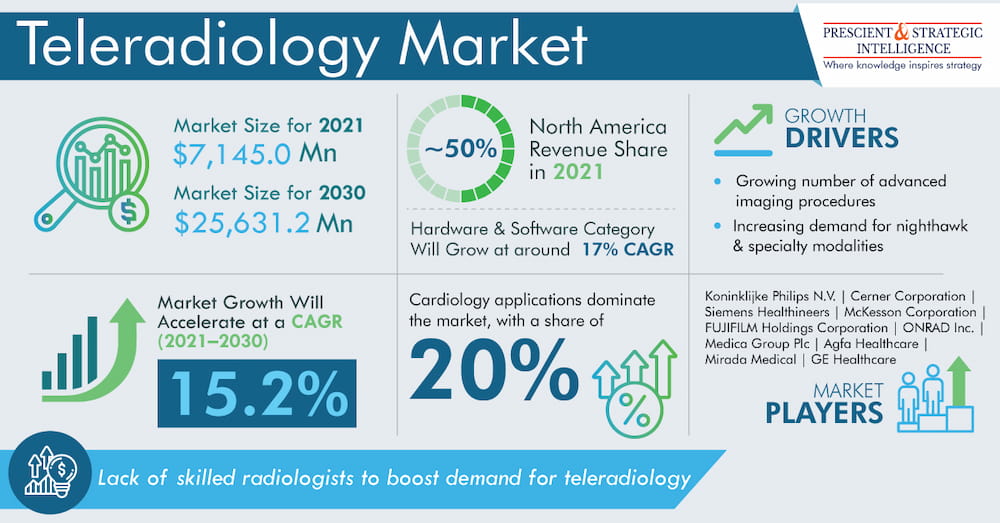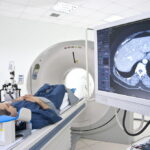The teleradiology market is expected to grow at a 15.2% CAGR in the span of 2021–2030, from $7,145.0 million in 2021 to $25,631.2 million by 2030. This will be because of a sharp increase in the volume of advanced imaging procedures worldwide. With the disease prevalence increasing day by day, there is an acute shortage of experienced radiologists. As per the stats of the Association of American Medical Colleges, there will be a shortage of around 122,000 medics in 2032.
As per the report of the WHO, globally, there are around 3,600 million radiological tests performed worldwide on an annual basis. The rate at which the radiological examination volume is rising will turn out to be an important factor for the growth of the teleradiology market in the coming years. Apart from this, the risk of cardiovascular diseases and cancer is on the rise, thus giving a boom to the market, since CT and MRI scans are widely conducted to diagnose them and during treatment.

There was a positive impact on this industry during the pandemic, with a prolific rise in the number of CT scans and chest X-rays. With rapid growth in the number of teleradiology tests, North America’s revenue share was the largest, at 50%, in 2021. Till now, the confirmed COVID-19 cases in the U.S. are 79,716,910, and a total of 979,321 deaths have been reported. This is the reason the popularity of the teleradiology concept was increasing by leaps and bounds and will continue to do so in the future also.
The scope of the teleradiology market will be better in the coming years as there is a prediction of a further rise in the demand for radio imaging. The use of artificial intelligence in this regard will facilitate teleradiology providers across the globe. This is because it can lessen the reading time and even ensure pinpoint accuracy. Stroke, which has emerged as one of the most-potent health scares, can be diagnosed by doctors in no time using AI-integrated radiology, which can help reduce the chance of death.

Key Findings of Teleradiology Market Report
- The WHO reports that over 3,600 million diagnostic radiological tests are performed per year worldwide, as the occurrence of chronic disorders.
- Moreover, as per Harvard Medical School, more than 80 million CT scans are executed in the U.S. per year.
- Koninklijke Philips N.V. and Akumin Inc. started a partnership in June 2021 to setup Philips’ modern radiology command center at the outpatient imaging centers of Akumin and create clinical standards of the latter’s MR and CT modalities.
- In 2021, with over 20% revenue share, cardiology applications led the teleradiology market because of the rapid enhancement in the incidence of cardiovascular diseases (CVDs). The WHO says that 32% of all deaths are caused by CVDs each year across the world. Additionally, of all the deaths from CVDs, 85% are because of strokes and heart attacks.
- In the U.K., as per the British Heart Foundation, circulatory and heart diseases are the reason for 460 deaths per day, which is about 160,000 deaths annually. Moreover, around 7.6 million people in the U.K. are living with circulatory or heart disease.
- The hardware and software category is projected to advance at a CAGR of around 17% from 2021 to 2030. It is attributed to the booming need for software in healthcare, which is why IT vendors are working to better technical capabilities, data transparency, and interoperability.
The hardware and software market is expected to show rapid growth, much faster than the service market, in the coming years. This is why every possible effort is being made by IT professionals to improve the operability and technical aspects of teleradiology. One of the foremost reasons for the growth of the teleradiology market is that most the hospitals are making use of these systems in order to improve healthcare efficiency during the COVID-19 outbreak.
The market was dominated by cardiology applications, with 20% revenue, in 2021, mainly because of an increase in the incidence of cardiovascular diseases (CVDs). There are approximately 18 million deaths because of CVDs every year, says the WHO. Out of the total deaths from CVDs, roughly 85% are due to strokes and heart attacks. Additionally, in the U.S., one person dies of a CVD every 36 seconds. It is principally why the U.S. has been a prime contributor to the revenue of the teleradiology market in the recent past.
Therefore, with the increase in the number of CVD cases, the demand for teleradiology solutions is experiencing a boom.
Read Also
- The Growing Need to Introduce Yoga Therapy in Hospitals
 Did you know that yoga means a union between the mind, body, and soul? It is an ancient form of physical healing tracing back 3000 years ago. Yoga improves or balances mental focus and eases body pain. Since the 18th century, its popularity has risen; now, over 36 million Americans perform yoga daily. Today, yogic… Read more: The Growing Need to Introduce Yoga Therapy in Hospitals
Did you know that yoga means a union between the mind, body, and soul? It is an ancient form of physical healing tracing back 3000 years ago. Yoga improves or balances mental focus and eases body pain. Since the 18th century, its popularity has risen; now, over 36 million Americans perform yoga daily. Today, yogic… Read more: The Growing Need to Introduce Yoga Therapy in Hospitals - How to Identify the Right Healthcare Franchise for Your Investment Strategy
 Are you an investor looking to capitalize on the ever-growing healthcare industry? Investing in a medical franchise can be a great way to diversify your portfolio and take advantage of ever-changing trends in the sector. To help you make the right choice, we’ve compiled this guide outlining all the key factors that will inform your… Read more: How to Identify the Right Healthcare Franchise for Your Investment Strategy
Are you an investor looking to capitalize on the ever-growing healthcare industry? Investing in a medical franchise can be a great way to diversify your portfolio and take advantage of ever-changing trends in the sector. To help you make the right choice, we’ve compiled this guide outlining all the key factors that will inform your… Read more: How to Identify the Right Healthcare Franchise for Your Investment Strategy - Global Diagnostic Imaging Services Market to Grow by CAGR of ~6% During 2023 – 2033
 Research Nester published a report titled “Diagnostic Imaging Services Market: Global Demand Analysis & Opportunity Outlook 2033” which delivers a detailed overview of the global diagnostic imaging services marketin terms of market segmentation by product, application, end-user, and by region. Further, for the in-depth analysis, the report encompasses the industry growth indicators, restraints, and supply… Read more: <strong>Global Diagnostic Imaging Services Market to Grow by CAGR of ~6% During 2023 – 2033</strong>
Research Nester published a report titled “Diagnostic Imaging Services Market: Global Demand Analysis & Opportunity Outlook 2033” which delivers a detailed overview of the global diagnostic imaging services marketin terms of market segmentation by product, application, end-user, and by region. Further, for the in-depth analysis, the report encompasses the industry growth indicators, restraints, and supply… Read more: <strong>Global Diagnostic Imaging Services Market to Grow by CAGR of ~6% During 2023 – 2033</strong> - What You Need to Know About Big Pharma
 When you trip and hurt your knee in real life, you take some pain medication and it starts to feel alright again. The same goes for the bruises you got when you were little – a trip to the pharmacist and you’ve got a nice soothing cream. Sounds lovely, doesn’t it? There’s a darker side… Read more: <strong>What You Need to Know About Big Pharma</strong>
When you trip and hurt your knee in real life, you take some pain medication and it starts to feel alright again. The same goes for the bruises you got when you were little – a trip to the pharmacist and you’ve got a nice soothing cream. Sounds lovely, doesn’t it? There’s a darker side… Read more: <strong>What You Need to Know About Big Pharma</strong> - Best Healthcare Businesses That Don’t Require a Degree
 Starting a business in the healthcare industry can be a rewarding and profitable venture,but it’s not always necessary to have a degree to be successful. Here are a fewexamples of healthcare businesses that can be started without a degree: 1- Medical Billing and Coding Medical billing and coding is a necessary aspect of running a… Read more: Best Healthcare Businesses That Don’t Require a Degree
Starting a business in the healthcare industry can be a rewarding and profitable venture,but it’s not always necessary to have a degree to be successful. Here are a fewexamples of healthcare businesses that can be started without a degree: 1- Medical Billing and Coding Medical billing and coding is a necessary aspect of running a… Read more: Best Healthcare Businesses That Don’t Require a Degree






